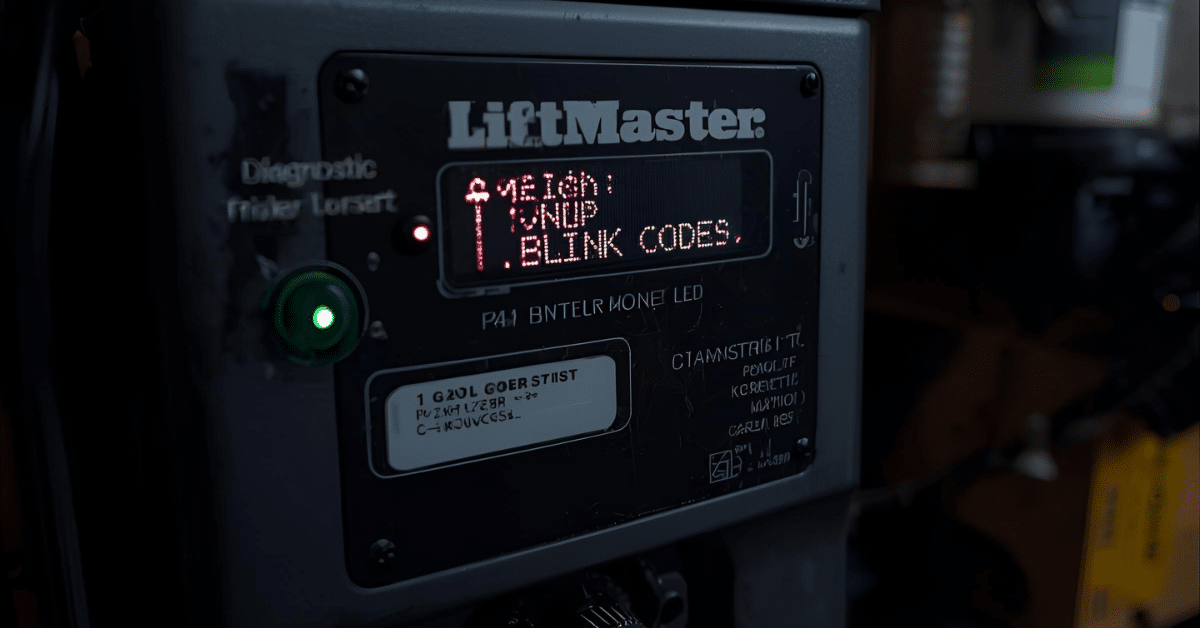If your garage door opener suddenly starts flashing its lights, you’re not alone. Many homeowners are puzzled why LiftMaster shows blink codes. These flashes are actually helpful signals known as LiftMaster blink codes, designed to alert you to specific problems so you can fix issues quickly and safely.
Understanding what these codes mean makes troubleshooting much easier—and often saves you from unnecessary repair costs.
What Are LiftMaster Blink Codes?
LiftMaster blink codes are diagnostic signals your opener uses to communicate an error. Instead of displaying a full message, the unit blinks in patterns to point you toward the exact problem.
These blinks come from two places:
- The LED light on the motor unit
- The safety sensor indicator lights
Each pattern corresponds to a particular issue, making the entire troubleshooting process faster and more accurate.
Common LiftMaster Blink Codes and Their Meanings
Since these codes are designed to simplify troubleshooting, reading them correctly is essential. Below are the most common LiftMaster blink codes you may see.
One Blink: Safety Sensor Issue
One blink usually signals a misaligned or blocked safety sensor.
These sensors sit near the bottom of the garage door tracks. If one is dirty, bumped, or blocked, the door won’t close for safety reasons.
Gently clean the lenses and ensure both sensors face each other directly.
Two Blinks: Wiring or Sensor Power Problem
Two blinks typically mean the safety sensors have no power or faulty wiring.
Check the wiring connections at the opener and sensors. A loose or damaged wire can interrupt the signal and trigger this blink pattern.
Three Blinks: Control Panel Issue
Three blinks often point to a shorted or malfunctioning control panel.
This can happen if the wall button wiring is damaged or if the control board itself is failing. Inspect the wires for cuts or pinching and test the opener with the remote.
Four to Five Blinks: Motor Overload
If you see four or five blinks, the motor may be overheating or overloaded.
The opener may shut down temporarily to protect itself. Let it cool for 15–20 minutes before trying again.
Rapid Blinking: Obstruction or Force Issue
Fast blinking lights often indicate that the door is hitting an obstruction or the opener’s force settings need adjustment.
Check for items blocking the door’s path and avoid adjusting the force without professional guidance.
Why LiftMaster Shows Blink Codes
Understanding the root cause helps you prevent future errors. Your LiftMaster may show blink codes because of:
- Sensor misalignment
- Damaged or disconnected wiring
- Obstructions in the door’s path
- Overheating or overloaded motor components
- Worn-out parts such as rollers or springs
- Faulty control panel or logic board
By accepting these codes as early warnings, you can fix issues before they become major repairs.
How to Fix LiftMaster Blink Code Problems
Troubleshooting LiftMaster blink codes doesn’t have to be complicated. Start with these simple steps:
- Check the Safety Sensors: Make sure both sensors are clean, aligned, and receiving power. Solid LED lights indicate they are working properly.
- Inspect the Wiring: Loose or frayed wires often cause blinking signals. Secure all connections and look for visible damage.
- Remove Garage Door Obstructions: Anything in the door’s path can trigger blink codes. Clear items like tools, boxes, or bikes from near the tracks.
- Test the Control Panel: Use the remote to determine if the wall button is malfunctioning. If the remote works but the button doesn’t, the panel may be faulty.
- Allow the Opener to Cool Down: If the motor is overloaded, give it time to rest before operating again.
When to Call a Professional
Even though some LiftMaster blink code issues are easy to fix, others require professional expertise. Call a technician if:
- The sensors have solid lights but the door still won’t close
- You suspect damaged wiring inside the walls
- The motor continues blinking after cooling down
- The opener makes grinding or unusual noises
- The door is off-track or visibly crooked
A trained expert can safely handle high-tension parts and prevent further damage.
Conclusion
When your garage door opener flashes, it’s not malfunctioning randomly—your unit is communicating. Understanding LiftMaster blink codes gives you control, saves time, and helps you keep your garage system running safely. Whether it’s a simple sensor alignment or a deeper wiring issue, these blink codes guide you toward the solution.
With the right knowledge and quick action, you can keep your LiftMaster operating smoothly and avoid unexpected breakdowns.





